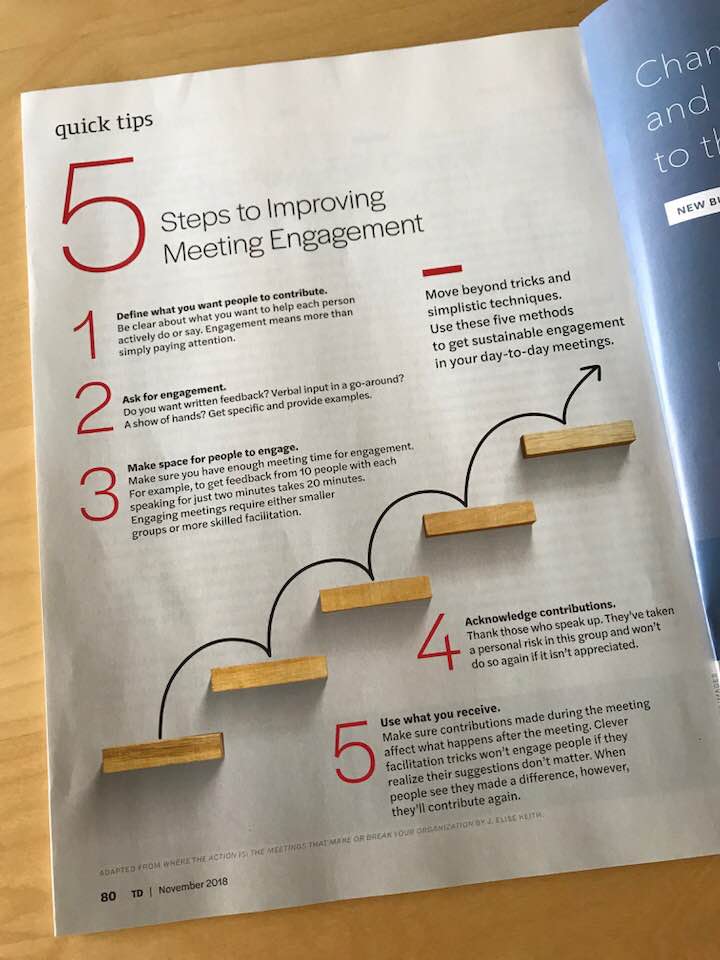5 Proven Techniques for Better Brainstorming
Meetings bring a group together to quickly discover answers and ideas that no one person can find by themselves.
Whether we’re working to negotiate the details of a new project, finding a way to tackle a challenging problem, or seeking to define our strategic vision, the pattern is the same; someone poses a question, and the group starts brainstorming answers.
Effective brainstorming is essential to nearly every type of business meeting.

Unfortunately, not all questions are created equally.
Sometimes the questions asked in a meeting don’t invite meaningful answers. Asking “Everyone good with that?” after dictating a decision isn’t an effective way to surface real concerns or get real commitments.
Some questions are too vague, making it unclear what kind of answer to give. Questions like “Do you have any feedback?” result in either polite non-replies (e.g., “Nope, I’m good.”) or long-winded side discussions that don’t necessarily get to the answers the group needs.
Getting great ideas from a group during a meeting can be hard, and for many participants, traditional brainstorming can feel like a painful waste of time.
First, despite the popularity of brainstorming sessions, we have some evidence that meetings aren’t always the best place to birth new ideas. Ideal or not, however, sometimes a meeting is the only real opportunity we have to explore ideas as a group, so we’d better make it work.
Second, our brains all work differently.
Not everyone does their best thinking on-demand.
Not every group welcomes new ideas, creating a social imperative to keep any answers within a comfortable range of safe topics.
Some people don’t seem to understand the difference between a group meeting and a personal consultation, taking it upon themselves to dominate the meeting by answering all the questions first, loudly, and in great detail.
The 5 Core Techniques for Better Brainstorming
Fortunately, there are proven and simple ways to help a group overcome the blank-slate challenge. If you search for “brainstorming techniques,” you’ll find all kinds of advice for various situations.
Underlying all the games and step-by-step activities, you’ll also discover a core set of techniques.
The 5 fundamental techniques below can be adapted for use by any group discussing any topic. Each technique helps groups overcome one or more of the most common and debilitating brainstorming challenges.
To illustrate these, we’ll imagine that we’re leading a planning meeting with a group that wants to open a new restaurant. As I’ll discuss at the end, once you know how to spot them, you’ll find opportunities to apply these techniques to nearly every meeting you’re in from here out.
1. Make it easy to answer with a powerful starting question.
About this Technique
Powerful starting questions help the group visualize their answers.
These questions fill the blank-slate in each person’s mind with a detailed picture. I learned this technique from Certified Master Facilitator Michael Wilkinson, and have since seen variations used in strategic planning, design workshops, and more.
It works like this:
Step 1: Introduce the topic.
Example:
“Now we’re going to create a list of all the things we need to get ready before opening night.”
Sadly, that’s as far as most people ever take it. They say “let’s make a list” and stand with markers ready while everyone else says “Hmmm, let me think.” That’s not what we’ll do here, though.
Step 2: Help the group to visualize the answers
Example:
“I want you to think about what will happen on that first night when we open the door. I want you to imagine those first customers walking in and looking around. I want you to think about how they’ll place an order, how we’ll prepare it and serve it, and how we’ll take care of them as they dine. I want you to see them paying the bill, and leaving happy.”
Pretty clear picture, right? This is going to be a long list!
Step 3: Ask the question.
Now, only after you’ve made it very easy for people to “see” their answers do you ask the basic question.
Example:
“What are all the things we need to get ready before opening night?”
When to Use a Powerful Starting Question
- When you need specific and detailed answers
- Any time the group is coming up blank
- As a replacement for common vague requests
- To prevent rote or “polite” replies
Basically, you should always try to use a powerful starting question.
Additional Resources
- See Michael’s video demonstration of the technique on YouTube
- For big changes and workshops, go deluxe by preparing an Experience Vision
2. Create a level playing field with silent brainstorming.
About this Technique
In traditional brainstorming, you ask a question and the group shouts out answers. The goal is to generate as many different ideas as possible in a short time.
Silent brainstorming works like regular brainstorming without the shouting part.
Instead of responding to the question verbally, each participant writes down as many ideas as they can think of in a fixed time. Groups that meet face-to-face will give everyone a stack of sticky notes, and everyone then writes one idea per note. At the end of the agreed upon time, people take turns sharing their ideas one at a time.

For our restaurant example, after we ask “What do we need to have ready for opening night?”, we would set a timer for 10 minutes. During this time, everyone would write their ideas separately. After the 10 minutes was up, the group would share ideas. We’d see “tables” on one sticky, “menus” on another, and so on.
Use Silent Brainstorming To:
- Get ideas from everyone, so one person’s ideas don’t drown out the others
- Ask harder questions that benefit from time for individual reflection before answering
- When meeting with introverts and others who otherwise don’t speak up
- When you need full participation and commitment from the group
For all these reasons, we use silent brainstorming rather than traditional brainstorming 9 times out of 10.
Additional Resources
- Using silent brainstorming for Agile estimation
- Brainwriting is a related technique that also comes in party form!
3. Get a different perspective with reverse brainstorming.
About this Technique
In reverse brainstorming, you ask the group to ponder failure or whatever the opposite is of your real goal.
Reverse brainstorming taps into our brain’s natural talent for negativity; we generally find it much easier to criticize and see the gaps in a plan than to outline the strategy for success.
Use this ingrained bias to your advantage, and help the group create a list of possible catastrophes you can then work to prevent.
For example:
“Imagine the opening night for our restaurant goes horribly wrong – so wrong that we have to shut down to recover. What might we have done to make that happen?”
The group could then reply: fail to get a license, use spoiled ingredients, get hair in the food, steal customer’s credit card numbers… you get the idea.
Once you have this list of really bad ideas, you can make plans to ensure none of them come to pass. A valid license, hairnets, quality food properly stored, and trusted staff all become obvious requirements for success.
Use Reverse Brainstorming To:
- Combat over-confidence or complacency in a group
- Improve an existing plan or strategy
- Strategize about the future or when attempting to predict an outcome
- When asking the positive version of the question doesn’t result in enough detail or feedback
Additional Resources
- How to run a reverse brainstorming sesion
- The 180 Rule makes this concept a key strategic tool
- The pre-mortem uses this technique to improve project planning
4. Create categories for responses.
About this Technique
Rather than ask the group for random answers, you can ask for answers in pre-defined categories.
This imposition of constraints is the thinking behind many popular strategic thinking frameworks such as the SWOT Analysis, which asks people to think about their company’s Strengths, Weaknesses, Opportunities and Threats as they answer how they fare against competitors in the market. You’ll also see this approach used to guide status updates and the feedback in agile retrospectives.
You can use this approach any time the range of possible answers is big and general.
In our restaurant example, instead of asking “What do we need for opening night?” we might ask people to list all the things we needed in these categories: Dining room, Menu, Staff, Business, etc.
Use Brainstorming Categories To:
- Narrow and focus answers to a big, broad question
- Add variety to a regular team meeting by switching up the categories for each person’s update
- As part of a pre-defined workshop, such as SWOT
Additional Resources
Categories positioned in a matrix invite participants to consider the question from opposing viewpoints, and there are tons of these.
Examples include:
- Porter’s 5 Forces for discussing business competition
- +/∆ for making simple pros/cons lists
- Circles and Soup for looking at factors you can control, and those you can’t
5. Move beyond the obvious with progressive questioning.
Sometimes a group can come up with an answer quickly, but it’s not always the answer they need.
Rather than try to ask the same question again and hope for a different answer (or worse, simply accept a hasty answer and move on), you can use a progressive questioning technique to lead the group to a better result.
Progressive questioning is a fancy way of saying that once you have that first answer, you keep digging and expanding on it until you feel the group really understands it by asking more questions.
There are several progressive questioning techniques designed to fit different situations.
- Using 5 Whys helps a group find the root cause of a problem.
- When conducting discovery for a new product or project, interviewers will ask questions that try to find the underlying values and needs behind a request.
- Educators, engineers, and psychiatrists use the Socratic questioning technique to enhance critical thinking.
- The Squid helps a group explore a space, responding in a series of answers and new questions until they’ve all shared everything they wonder about and collectively know on a topic.
Use Progressive Questioning To:
- Uncover the deeper reason behind a problem or request
- Explore the more nuanced aspects of an idea
- Challenge the group’s critical thinking on a topic
Combining Techniques
The order of the techniques listed above is no accident. If you read through them in order, I’m sure you realized that they work nicely together.
- For best results, begin every brainstorm with technique 1: the powerful starting question.
- Use this question to kick-off silent brainstorming, reverse brainstorming, or brainstorming in categories.
- Use progressive questioning to get greater clarity on one or two key ideas.
Want to see examples of how this works in context?
Take a look at the Essential Project Kickoff to see powerful starting questions used first in a silent brainstorm, then later in a reverse brainstorm.
The Project Retrospective and Strategic Planning meetings all include good examples of brainstorming in categories.
Finally, the Kaizen Event Template uses the 5 Whys progressive questioning technique to effectively refine a group’s business process.
Final tip: Take it beyond brainstorming!
Brainstorming sessions are a great place to test and refine these techniques, but once you understand them, don’t let it stop there!
Any time you ask a question, consider the wisdom of the powerful starting question and how you can make it easy for someone to give you a better answer.
Any time you’re feeling rushed to reply to a question before you’re ready, remember how quiet moments in silent brainstorming work for a group, and allow yourself the time you need to gather your thoughts.
Any time you’re stuck on a problem, consider breaking it down into categories, or coming at it from the opposite direction.
Finally, notice when you and those around you are making assumptions or rationalizing, and apply progressive questioning to get past all the unavoidable cognitive biases to a more confident and well-grounded answer.
More? Please Share!
Do you know another core brainstorming technique, or have a favorite brainstorming game people should use more often? Let us all know in the comments below!



